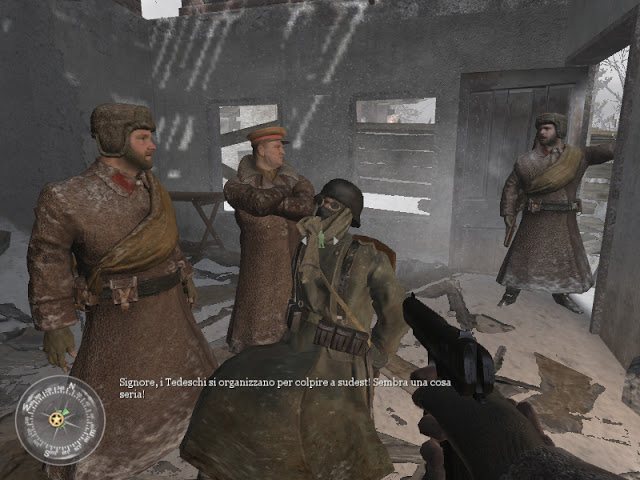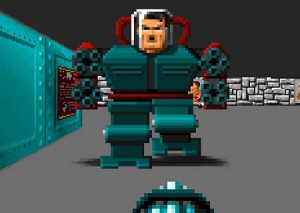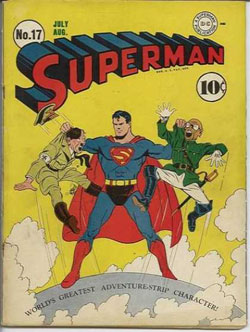Enemies within the scope of the real world are difficult to choose for video games. With science fiction games, like Halo, or fantasy games, like Skyrim, universally acceptable enemies like aliens or dragons can be used without any sort of outcry from the public. Some modern shooters have turned to former superpower, Russia, or current superpower, China, as their enemies, which has created some negative response from the two nations. It comes as no surprise then that Nazis have been used extensively in video games as the enemy. The Nazis of Germany are gone and the only remnants are neo-nazi groups, which are generally condemned by western society. What can our use of them in video games say about the contemporary view of Nazis? For the sake of brevity I will look at the use of Nazis in just Call of Duty 2, Call of Duty: World at War, and Wolfenstein 3D.

Call of Duty 2 is about as realistic a Second World War shooter as you can find. The battles and dress of the soldiers are realistic and the gameplay is meant to replicate a Second World War battle accurately. In the first mission of Call of Duty 2, the player controls Russian soldier Vasili Koslov. After completing basic training, the player is led to a room where a group of Russian soldiers are ‘interrogating’ a captured German soldier. After the soldier receives several punches to the face, he begins to talk. Witnessing a torture scene even if only in-game is generally unpleasant but this scene is easy to stomach because the enemy has been reduced to a gas mask and trench coat. The mask obscures the entirety of his face and eyes so the soldier seems inhuman. After this initial scene, most of the Nazis the player encounters in the Russian campaign also sport some sort of mask. Once the player reaches the British and later American campaigns, the Nazis faces appear more regularly. By doing this, the player accepts that the Nazi soldiers are not human and just another enemy. Then, as the game goes on the Nazis are slowly transitioned into more realistic models but by then the player has already accepted them as the enemy. Even in a realistic portrayal of the war, Nazis are dehumanized.
This differs from what is typically done in high profile Second World War film or television recreations. Saving Private Ryan and Band of Brothers use scenes that elicit sympathy for Nazi soldiers. In Saving Private Ryan, near the end of the D-Day landings, Nazi soldier start surrendering to the victorious Americans. Not all Nazi soldiers are taken prisoner though and in one scene, two trembling Nazis beg to a pair of Americans not to kill them. The Americans ignore their pleas and are murdered in cold blood. In the sixth episode of Band of Brothers, the audience watches as Major Dick Winter struggles to deal with the guilt after he kills a very young German soldier. These scenes create sympathy for the enemy and display their similarities to the Allied soldiers. While this is a common trope in Second World War television and film, they are rarely found in games.

The next two games will show more extreme examples of bastardized Nazism for the purpose of gameplay. Wolfenstein 3D (1992) is an extremely popular video game and often cited as one of the most important games in the history of the first person shooter genre. It also extremely deforms Nazi soldiers. The game takes place in the fictional Castle Wolfenstein and the player must infiltrate said castle to find Nazis performing mad science experiments. The experiments produce enemies like Nazi zombies and mutants. The most heinous of all the enemies encountered in this game though is the final boss, a mechanized robot version of Adolf Hitler. Without a doubt, the leader of the third reich is one of the most evil humans in history but to take his image and distort it so viciously is beyond what is to be expected. Wolfenstein 3D is not the only game that has twisted Nazism for the purpose of gameplay.
Call of Duty: World at War‘s very addictive and enjoyable Nazi Zombies mode warps the traditional views of Nazi soldiers. The brand new gameplay mode puts two presumably Allied troops in an abandoned house that must be defended from never ending waves of Third Reich undead. The player slowly better equips themselves so that they can be more effective killers of these creatures. This is strange for a Call of Duty game as the series had up until this point generally maintained a degree of seriousness when dealing with the Second World War. While the Nazi Zombie mode is very fun and likely not meant to be anything more than a way for the developers to give a few more hours of gameplay to the player, it still shows that Nazis are an enemy that can be manipulated without much thought going into it.

To be noted, the notion of Nazi zombies and even debauching the Nazi image in general was not a creation of the video game. Indiana Jones, Superman and many other popular culture icons have fought some corrupt version of Nazis in the past. However, in recent years, Nazi zombies (as well as other twisted Nazi forms) have for the most part been banished to B and C-list movies. So it is abnormal in popular culture for games featuring bizarre forms of Nazism to have success (Call of Duty: World at War sold 16.75 million copies).
Nazism is an easy target for video games. It makes sense and helps explain why so many video games have been set in the Second World War (for more on this see here). However, the fact that Nazis are bastardized is a testament to our memory of the Second World War and the Third Reich. The Second World War is sometimes referred to by Western culture as the “Good War.” An extension of this is that the Allies were good and the Nazis were evil. This post is not here to explore the validity of those statements but for certain they are not uncommon. What has been shown though is that Nazism is used in video games in a number of ways. Sometimes Nazis are the enemy and are dehumanized in order to make it easier for players to accept that. Other times Nazis are twisted and mutated into more sinister and heinous enemies. What is next for games though? If they can follow in the footsteps of their film and television counterparts, maybe we will see Second World War games in the future where Nazi soldiers are more similar to their Allied counterparts than different.

Awesome article bro!
Good choice of topic – the “nazis are basically morally equivalent to zombies already” thing is an aspect of games I’ve always found interesting to look into.
Although the Saving Private Ryan thing with the surrendering soldiers is even more deliberately morally muddled than you suggest: the soldier is saying, apparently, “Please don’t shoot me, I am not German, I am Czech, I didn’t kill anyone, I am Czech!” in Czech when they shoot him.
Wow, I honestly did not know that about the translation of the German soldiers in Saving Private Ryan. Glad you enjoyed the topic.
I want to see more hardcore video games from the Nazi point of view.